
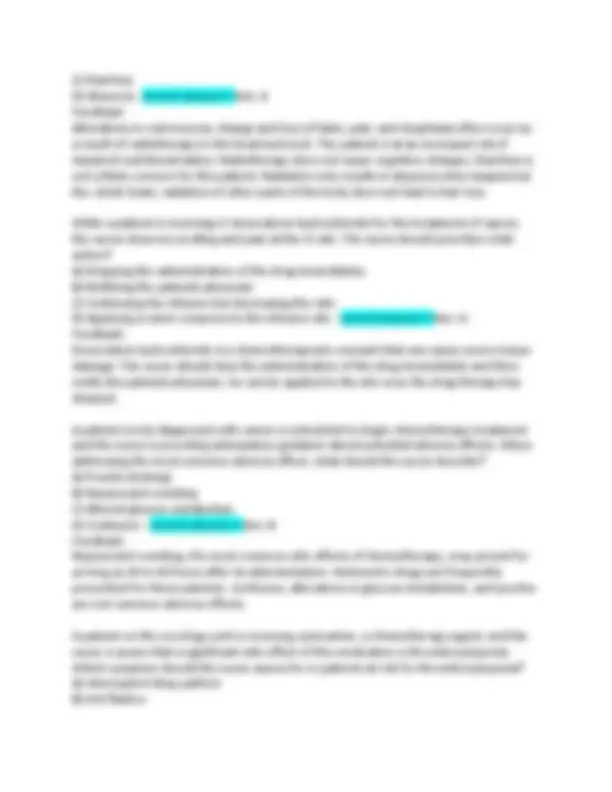
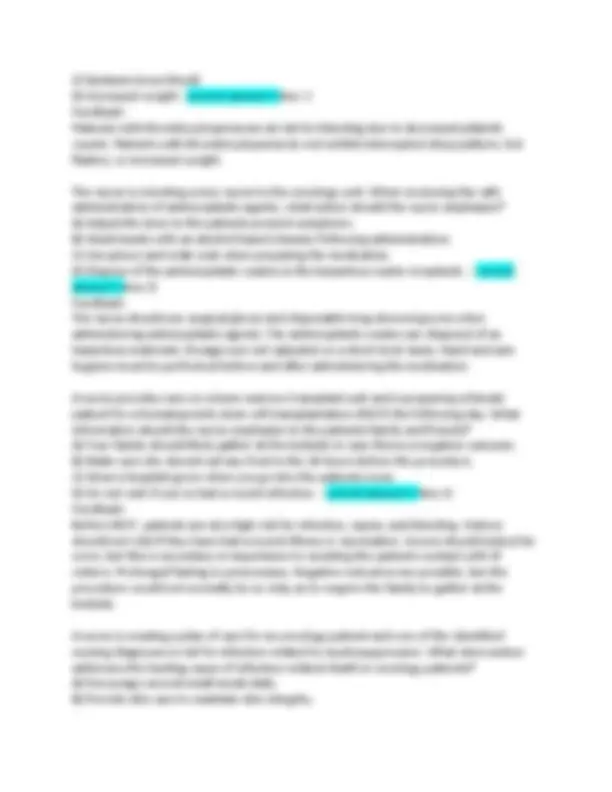


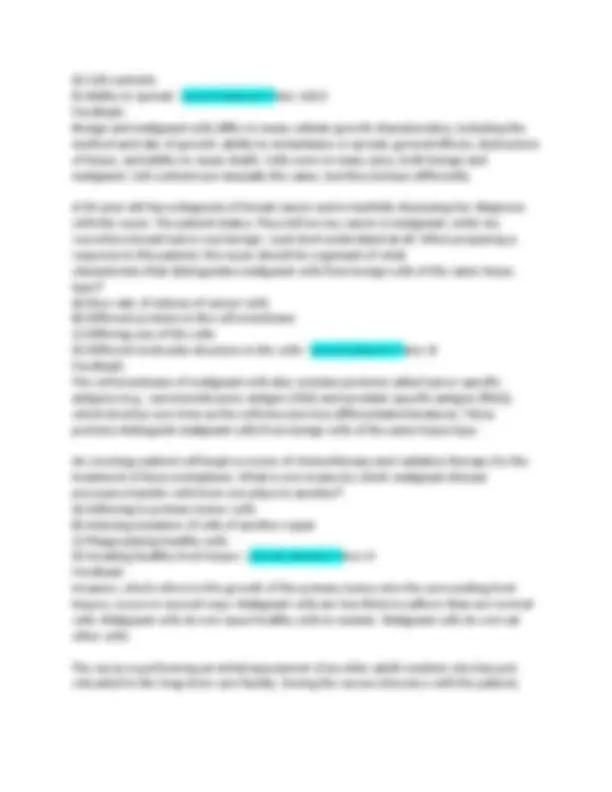
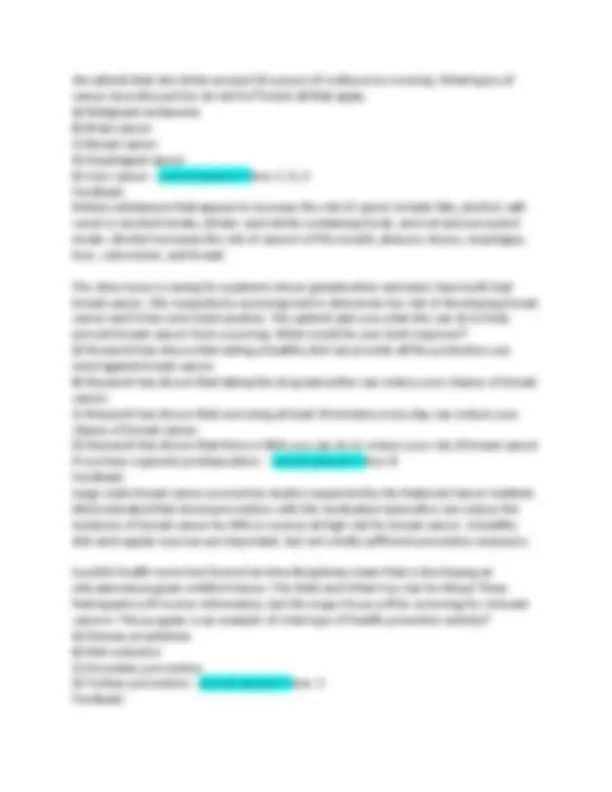
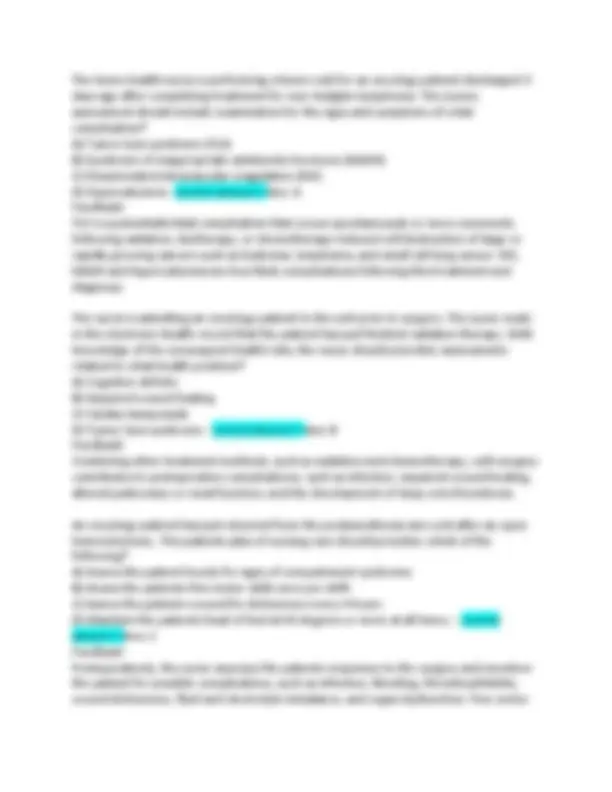
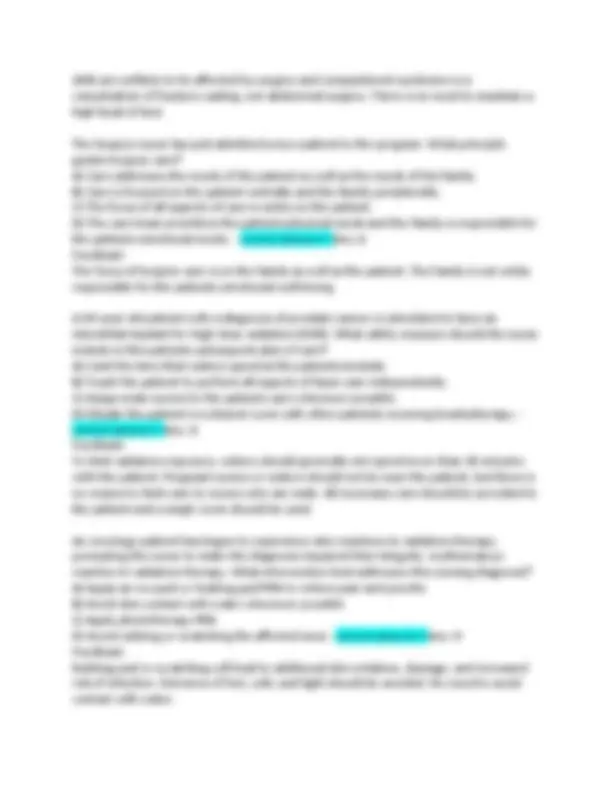
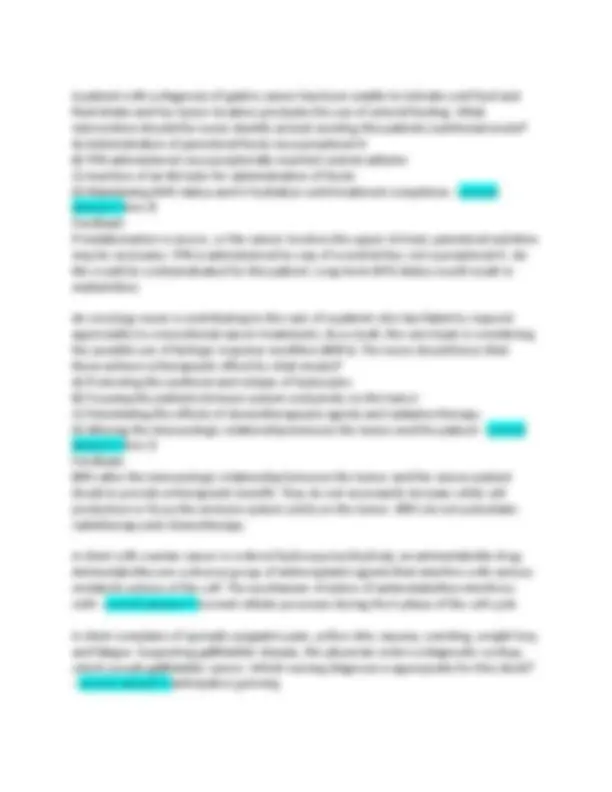
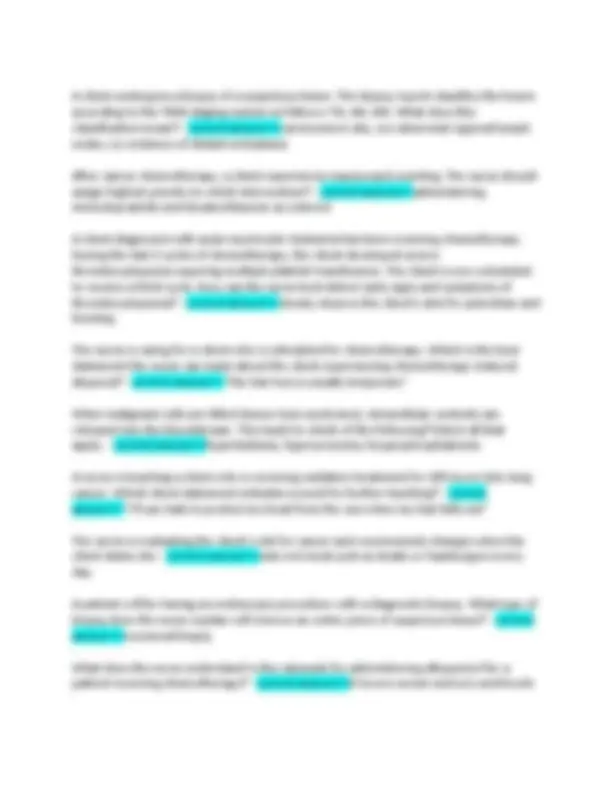
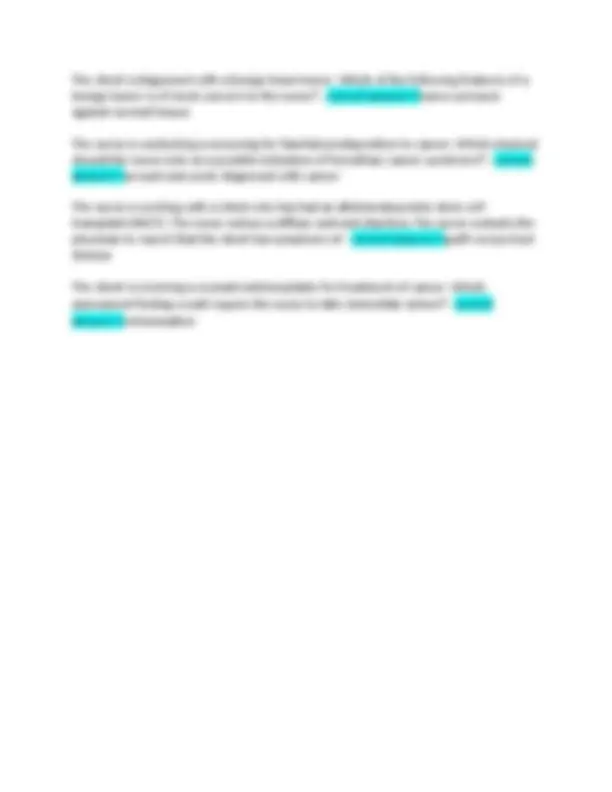


Study with the several resources on Docsity

Earn points by helping other students or get them with a premium plan


Prepare for your exams
Study with the several resources on Docsity

Earn points to download
Earn points by helping other students or get them with a premium plan
Community
Ask the community for help and clear up your study doubts
Discover the best universities in your country according to Docsity users
Free resources
Download our free guides on studying techniques, anxiety management strategies, and thesis advice from Docsity tutors
The public health nurse is presenting a health-promotion class to a group at a local community center. Which intervention most directly addresses the leading cause of cancer deaths in North America? A) Monthly self-breast exams B) Smoking cessation C) Annual colonoscopies D) Monthly testicular exams - correct answer>>Ans: B Feedback: Cancer is second only to cardiovascular disease as a leading cause of death in the United States. Although the numbers of cancer deaths have decreased slightly, more than 570,000 Americans were expected to die from a malignant process in 2011. The leading causes of cancer death in the United States, in order of frequency, are lung, prostate, and colorectal cancer in men and lung, breast, and colorectal cancer in women, so smoking cessation is the health promotion initiative directly related to lung cancer. A nurse who works in an oncology clinic is assessing a patient who has arrived for a 2
Typology: Exams
1 / 19

This page cannot be seen from the preview
Don't miss anything!












The public health nurse is presenting a health-promotion class to a group at a local community center. Which intervention most directly addresses the leading cause of cancer deaths in North America? A) Monthly self-breast exams B) Smoking cessation C) Annual colonoscopies D) Monthly testicular exams - correct answer>>Ans: B Feedback: Cancer is second only to cardiovascular disease as a leading cause of death in the United States. Although the numbers of cancer deaths have decreased slightly, more than 570,000 Americans were expected to die from a malignant process in 2011. The leading causes of cancer death in the United States, in order of frequency, are lung, prostate, and colorectal cancer in men and lung, breast, and colorectal cancer in women, so smoking cessation is the health promotion initiative directly related to lung cancer. A nurse who works in an oncology clinic is assessing a patient who has arrived for a 2- month follow-up appointment following chemotherapy. The nurse notes that the patients skin appears yellow. Which blood tests should be done to further explore this clinical sign? A) Liver function tests (LFTs) B) Complete blood count (CBC) C) Platelet count D) Blood urea nitrogen and creatinine - correct answer>>Ans: A Feedback: Yellow skin is a sign of jaundice and the liver is a common organ affected by metastatic disease. An LFT should be done to determine if the liver is functioning. A CBC, platelet count and tests of renal function would not directly assess for liver disease. The school nurse is teaching a nutrition class in the local high school. One student states that he has heard that certain foods can increase the incidence of cancer. The nurse responds, Research has shown that certain foods indeed appear to increase the risk of cancer. Which of the following menu selections would be the best choice for potentially reducing the risks of cancer? A) Smoked salmon and green beans B) Pork chops and fried green tomatoes
C) Baked apricot chicken and steamed broccoli D) Liver, onions, and steamed peas - correct answer>>Ans: C Feedback: Fruits and vegetables appear to reduce cancer risk. Salt-cured foods, such as ham and processed meats, as well as red meats, should be limited. Traditionally, nurses have been involved with tertiary cancer prevention. However, an increasing emphasis is being placed on both primary and secondary prevention. What would be an example of primary prevention? A) Yearly Pap tests B) Testicular self-examination C) Teaching patients to wear sunscreen D) Screening mammograms - correct answer>>Ans: C Feedback: Primary prevention is concerned with reducing the risks of cancer in healthy people through practices such as use of sunscreen. Secondary prevention involves detection and screening to achieve early diagnosis, as demonstrated by Pap tests, mammograms, and testicular exams. The nurse is caring for a 39-year-old woman with a family history of breast cancer. She requested a breast tumor marking test and the results have come back positive. As a result, the patient is requesting a bilateral mastectomy. This surgery is an example of what type of oncologic surgery? A) Salvage surgery B) Palliative surgery C) Prophylactic surgery D) Reconstructive surgery - correct answer>>Ans: C Feedback: Prophylactic surgery is used when there is an extensive family history and nonvital tissues are removed. Salvage surgery is an additional treatment option that uses an extensive surgical approach to treat the local recurrence of a cancer after the use of a less extensive primary approach. Palliative surgery is performed in an attempt to relieve complications of cancer, such as ulceration, obstruction, hemorrhage, pain, and malignant effusion. Reconstructive surgery may follow curative or radical surgery in an attempt to improve function or obtain a more desirable cosmetic effect. The nurse is caring for a patient who is to begin receiving external radiation for a malignant tumor of the neck. While providing patient education, what potential adverse effects should the nurse discuss with the patient? A) Impaired nutritional status B) Cognitive changes
C) Epistaxis (nose bleed) D) Increased weight - correct answer>>Ans: C Feedback: Patients with thrombocytopenia are at risk for bleeding due to decreased platelet counts. Patients with thrombocytopenia do not exhibit interrupted sleep pattern, hot flashes, or increased weight. The nurse is orienting a new nurse to the oncology unit. When reviewing the safe administration of antineoplastic agents, what action should the nurse emphasize? A) Adjust the dose to the patients present symptoms. B) Wash hands with an alcohol-based cleanser following administration. C) Use gloves and a lab coat when preparing the medication. D) Dispose of the antineoplastic wastes in the hazardous waste receptacle. - correct answer>>Ans: D Feedback: The nurse should use surgical gloves and disposable long-sleeved gowns when administering antineoplastic agents. The antineoplastic wastes are disposed of as hazardous materials. Dosages are not adjusted on a short-term basis. Hand and arm hygiene must be performed before and after administering the medication. A nurse provides care on a bone marrow transplant unit and is preparing a female patient for a hematopoietic stem cell transplantation (HSCT) the following day. What information should the nurse emphasize to the patients family and friends? A) Your family should likely gather at the bedside in case theres a negative outcome. B) Make sure she doesnt eat any food in the 24 hours before the procedure. C) Wear a hospital gown when you go into the patients room. D) Do not visit if you've had a recent infection. - correct answer>>Ans: D Feedback: Before HSCT, patients are at a high risk for infection, sepsis, and bleeding. Visitors should not visit if they have had a recent illness or vaccination. Gowns should indeed be worn, but this is secondary in importance to avoiding the patients contact with ill visitors. Prolonged fasting is unnecessary. Negative outcomes are possible, but the procedure would not normally be so risky as to require the family to gather at the bedside. A nurse is creating a plan of care for an oncology patient and one of the identified nursing diagnoses is risk for infection related to myelosuppression. What intervention addresses the leading cause of infection-related death in oncology patients? A) Encourage several small meals daily. B) Provide skin care to maintain skin integrity.
C) Assist the patient with hygiene, as needed. D) Assess the integrity of the patients oral mucosa regularly. - correct answer>>Ans: B Feedback: Nursing care for patients with skin reactions includes maintaining skin integrity, cleansing the skin, promoting comfort, reducing pain, preventing additional trauma, and preventing and managing infection. Malnutrition in oncology patients may be present, but it is not the leading cause of infection-related death. Poor hygiene does not normally cause events that result in death. Broken oral mucosa may be an avenue for infection, but it is not the leading cause of death in an oncology patient. You are caring for an adult patient who has developed a mild oral yeast infection following chemotherapy. What actions should you encourage the patient to perform? Select all that apply. A) Use a lip lubricant. B) Scrub the tongue with a firm-bristled toothbrush. C) Use dental floss every 24 hours. D) Rinse the mouth with normal saline. E) Eat spicy food to aid in eradicating the yeast. - correct answer>>Ans: A, C, D Feedback: Stomatitis is an inflammation of the oral cavity. The patient should be encouraged to brush the teeth with a soft toothbrush after meals, use dental floss every 24 hours, rinse with normal saline, and use a lip lubricant. Mouthwashes and hot foods should be avoided. The nurse on a bone marrow transplant unit is caring for a patient with cancer who is preparing for HSCT. What is a priority nursing diagnosis for this patient? A) Fatigue related to altered metabolic processes B) Altered nutrition: less than body requirements related to anorexia C) Risk for infection related to altered immunologic response D) Body image disturbance related to weight loss and anorexia - correct answer>>Ans: C Feedback: A priority nursing diagnosis for this patient is risk for infection related to altered immunologic response. Because the patients immunity is suppressed, he or she will be at a high risk for infection. The other listed nursing diagnoses are valid, but they are not as high a priority as is risk for infection. An oncology nurse is caring for a patient who has developed erythema following radiation therapy. What should the nurse instruct the patient to do? A) Periodically apply ice to the area. B) Keep the area cleanly shaven.
A 16-year-old female patient experiences alopecia resulting from chemotherapy, prompting the nursing diagnoses of disturbed body image and situational low self- esteem. What action by the patient would best indicate that she is meeting the goal of improved body image and self-esteem? A) The patient requests that her family bring her makeup and wig. B) The patient begins to discuss the future with her family. C) The patient reports less disruption from pain and discomfort. D) The patient cries openly when discussing her disease. - correct answer>>Ans: A Feedback: Requesting her wig and makeup indicates that the patient with alopecia is becoming interested in looking her best and that her body image and self-esteem may be improving. The other options may indicate that other nursing goals are being met, but they do not necessarily indicate improved body image and self-esteem. A 50-year-old man diagnosed with leukemia will begin chemotherapy. What would the nurse do to combat the most common adverse effects of chemotherapy? A) Administer an antiemetic. B) Administer an antimetabolite. C) Administer a tumor antibiotic. D) Administer an anticoagulant. - correct answer>>Ans: A Feedback: Antiemetics are used to treat nausea and vomiting, the most common adverse effects of chemotherapy. Antihistamines and certain steroids are also used to treat nausea and vomiting. Antimetabolites and tumor antibiotics are classes of chemotherapeutic medications. Anticoagulants slow blood clotting time, thereby helping to prevent thrombi and emboli. A 58-year-old male patient has been hospitalized for a wedge resection of the left lower lung lobe after a routine chest x-ray shows carcinoma. The patient is anxious and asks if he can smoke. Which statement by the nurse would be most therapeutic? A) Smoking is the reason you are here. B) The doctor left orders for you not to smoke. C) You are anxious about the surgery. Do you see smoking as helping? D) Smoking is OK right now, but after your surgery it is contraindicated. - correct answer>>Ans: C Feedback: Stating You are anxious about the surgery. Do you see smoking as helping? acknowledges the patients feelings and encourages him to assess his previous behavior. Saying Smoking is the reason you are here belittles the patient. Citing the doctors orders
does not address the patients anxiety. Sanctioning smoking would be highly detrimental to this patient. An oncology nurse educator is providing health education to a patient who has been diagnosed with skin cancer. The patients wife has asked about the differences between normal cells and cancer cells. What characteristic of a cancer cell should the educator cite? A) Malignant cells contain more fibronectin than normal body cells. B) Malignant cells contain proteins called tumor-specific antigens. C) Chromosomes contained in cancer cells are more durable and stable than those of normal cells. D) The nuclei of cancer cells are unusually large, but regularly shaped. - correct answer>>Ans: B Feedback: The cell membranes are altered in cancer cells, which affect fluid movement in and out of the cell. The cell membrane of malignant cells also contains proteins called tumor- specific antigens. Malignant cellular membranes also contain less fibronectin, a cellular cement. Typically, nuclei of cancer cells are large and irregularly shaped (pleomorphism). Fragility of chromosomes is commonly found when cancer cells are analyzed. A patients most recent diagnostic imaging has revealed that his lung cancer has metastasized to his bones and liver. What is the most likely mechanism by which the patients cancer cells spread? A) Hematologic spread B) Lymphatic circulation C) Invasion D) Angiogenesis - correct answer>>Ans: B Feedback: Lymph and blood are key mechanisms by which cancer cells spread. Lymphatic spread (the transport of tumor cells through the lymphatic circulation) is the most common mechanism of metastasis. The nurse is describing some of the major characteristics of cancer to a patient who has recently received a diagnosis of malignant melanoma. When differentiating between benign and malignant cancer cells, the nurse should explain differences in which of the following aspects? Select all that apply. A) Rate of growth B) Ability to cause death C) Size of cells
she admits that she drinks around 20 ounces of vodka every evening. What types of cancer does this put her at risk for? Select all that apply. A) Malignant melanoma B) Brain cancer C) Breast cancer D) Esophageal cancer E) Liver cancer - correct answer>>Ans: C, D, E Feedback: Dietary substances that appear to increase the risk of cancer include fats, alcohol, salt- cured or smoked meats, nitrate- and nitrite-containing foods, and red and processed meats. Alcohol increases the risk of cancers of the mouth, pharynx, larynx, esophagus, liver, colorectum, and breast. The clinic nurse is caring for a patient whose grandmother and sister have both had breast cancer. She requested a screening test to determine her risk of developing breast cancer and it has come back positive. The patient asks you what she can do to help prevent breast cancer from occurring. What would be your best response? A) Research has shown that eating a healthy diet can provide all the protection you need against breast cancer. B) Research has shown that taking the drug tamoxifen can reduce your chance of breast cancer. C) Research has shown that exercising at least 30 minutes every day can reduce your chance of breast cancer. D) Research has shown that there is little you can do to reduce your risk of breast cancer if you have a genetic predisposition. - correct answer>>Ans: B Feedback: Large-scale breast cancer prevention studies supported by the National Cancer Institute (NCI) indicated that chemoprevention with the medication tamoxifen can reduce the incidence of breast cancer by 50% in women at high risk for breast cancer. A healthy diet and regular exercise are important, but not wholly sufficient preventive measures. A public health nurse has formed an interdisciplinary team that is developing an educational program entitled Cancer: The Risks and What You Can Do About Them. Participants will receive information, but the major focus will be screening for relevant cancers. This program is an example of what type of health promotion activity? A) Disease prophylaxis B) Risk reduction C) Secondary prevention D) Tertiary prevention - correct answer>>Ans: C Feedback:
Secondary prevention involves screening and early detection activities that seek to identify early stage cancer in individuals who lack signs and symptoms suggestive of cancer. Primary prevention is concerned with reducing the risks of disease through health promotion strategies. Tertiary prevention is the care and rehabilitation of the patient after having been diagnosed with cancer. A 62-year-old woman diagnosed with breast cancer is scheduled for a partial mastectomy. The oncology nurse explained that the surgeon will want to take tissue samples to ensure the disease has not spread to adjacent axillary lymph nodes. The patient has asked if she will have her lymph nodes dissected, like her mother did several years ago. What alternative to lymph node dissection will this patient most likely undergo? A) Lymphadenectomy B) Needle biopsy C) Open biopsy D) Sentinel node biopsy - correct answer>>Ans: D Feedback: Sentinel lymph node biopsy (SLNB), also known as sentinel lymph node mapping, is a minimally invasive surgical approach that, in some instances, has replaced more invasive lymph node dissections (lymphadenectomy) and their associated complications such as lymphedema and delayed healing. SLNB has been widely adopted for regional lymph node staging in selected cases of melanoma and breast cancer. You are caring for a patient who has just been told that her stage IV colon cancer has recurred and metastasized to the liver. The oncologist offers the patient the option of surgery to treat the progression of this disease. What type of surgery does the oncologist offer? A) Palliative B) Reconstructive C) Salvage D) Prophylactic - correct answer>>Ans: A Feedback: When cure is not possible, the goals of treatment are to make the patient as comfortable as possible and to promote quality of life as defined by the patient and his or her family. Palliative surgery is performed in an attempt to relieve complications of cancer, such as ulceration, obstruction, hemorrhage, pain, and malignant effusion. Reconstructive surgery may follow curative or radical surgery in an attempt to improve function or obtain a more desirable cosmetic effect. Salvage surgery is an additional treatment option that uses an extensive surgical approach to treat the local recurrence
The home health nurse is performing a home visit for an oncology patient discharged 3 days ago after completing treatment for non-Hodgkin lymphoma. The nurses assessment should include examination for the signs and symptoms of what complication? A) Tumor lysis syndrome (TLS) B) Syndrome of inappropriate antiduretic hormone (SIADH) C) Disseminated intravascular coagulation (DIC) D) Hypercalcemia - correct answer>>Ans: A Feedback: TLS is a potentially fatal complication that occurs spontaneously or more commonly following radiation, biotherapy, or chemotherapy-induced cell destruction of large or rapidly growing cancers such as leukemia, lymphoma, and small cell lung cancer. DIC, SIADH and hypercalcemia are less likely complications following this treatment and diagnosis. The nurse is admitting an oncology patient to the unit prior to surgery. The nurse reads in the electronic health record that the patient has just finished radiation therapy. With knowledge of the consequent health risks, the nurse should prioritize assessments related to what health problem? A) Cognitive deficits B) Impaired wound healing C) Cardiac tamponade D) Tumor lysis syndrome - correct answer>>Ans: B Feedback: Combining other treatment methods, such as radiation and chemotherapy, with surgery contributes to postoperative complications, such as infection, impaired wound healing, altered pulmonary or renal function, and the development of deep vein thrombosis. An oncology patient has just returned from the postanesthesia care unit after an open hemicolectomy. This patients plan of nursing care should prioritize which of the following? A) Assess the patient hourly for signs of compartment syndrome. B) Assess the patients fine motor skills once per shift. C) Assess the patients wound for dehiscence every 4 hours. D) Maintain the patients head of bed at 45 degrees or more at all times. - correct answer>>Ans: C Feedback: Postoperatively, the nurse assesses the patients responses to the surgery and monitors the patient for possible complications, such as infection, bleeding, thrombophlebitis, wound dehiscence, fluid and electrolyte imbalance, and organ dysfunction. Fine motor
skills are unlikely to be affected by surgery and compartment syndrome is a complication of fracture casting, not abdominal surgery. There is no need to maintain a high head of bed. The hospice nurse has just admitted a new patient to the program. What principle guides hospice care? A) Care addresses the needs of the patient as well as the needs of the family. B) Care is focused on the patient centrally and the family peripherally. C) The focus of all aspects of care is solely on the patient. D) The care team prioritizes the patients physical needs and the family is responsible for the patients emotional needs. - correct answer>>Ans: A Feedback: The focus of hospice care is on the family as well as the patient. The family is not solely responsible for the patients emotional well-being A 60-year-old patient with a diagnosis of prostate cancer is scheduled to have an interstitial implant for high-dose radiation (HDR). What safety measure should the nurse include in this patients subsequent plan of care? A) Limit the time that visitors spend at the patients bedside. B) Teach the patient to perform all aspects of basic care independently. C) Assign male nurses to the patients care whenever possible. D) Situate the patient in a shared room with other patients receiving brachytherapy. - correct answer>>Ans: A Feedback: To limit radiation exposure, visitors should generally not spend more than 30 minutes with the patient. Pregnant nurses or visitors should not be near the patient, but there is no reason to limit care to nurses who are male. All necessary care should be provided to the patient and a single room should be used. An oncology patient has begun to experience skin reactions to radiation therapy, prompting the nurse to make the diagnosis Impaired Skin Integrity: erythematous reaction to radiation therapy. What intervention best addresses this nursing diagnosis? A) Apply an ice pack or heating pad PRN to relieve pain and pruritis B) Avoid skin contact with water whenever possible C) Apply phototherapy PRN D) Avoid rubbing or scratching the affected area - correct answer>>Ans: D Feedback: Rubbing and or scratching will lead to additional skin irritation, damage, and increased risk of infection. Extremes of hot, cold, and light should be avoided. No need to avoid contact with water.
A nurse is caring for a client who is receiving chemotherapy and has a platelet count of 30,000/mm3. Which statement by the client indicates a need for additional teaching? - correct answer>>"I floss my teeth every morning" Your client is receiving radiation therapy. The client asks you about oral hygiene. What advice regarding oral hygiene should you offer? - correct answer>>use a soft toothbrush and avoid an electronic toothbrush Which should a nurse thoroughly evaluate before a bone marrow transplant (BMT) procedure? - correct answer>>blood studies A cancer client makes the following statement to the nurse: "I guess I will tell my doctor to forego the chemotherapy. I do not want to be throwing up all the time. I would rather die."Which of the following facts supports the use of chemotherapy for this client? - correct answer>>chemotherapy treatment can be adjusted to optimize effects while limiting adverse effects A patient will be receiving radiation for 6 weeks for the treatment of breast cancer and asks the nurse why it takes so long. What is the best response by the nurse? - correct answer>>"It will decrease the incidence of leukopenia and thrombocytopenia" What intervention should the nurse provide to reduce the incidence of renal damage when a patient is taking a chemotherapy regimen? - correct answer>>encourage fluid intake to dilute the urine Which type of vaccine uses the client's own cancer cells, which are killed and prepared for injection back into the client? - correct answer>>autologous Which primary cancer treatment goal is prolonged survival and containment of cancer cell growth? - correct answer>>control A patient is scheduled for cryosurgery for cervical cancer and tells the nurse, "I am not exactly sure what the doctor is going to do." What is the best response by the nurse? - correct answer>>"the physician is going to use liquid nitrogen to freeze the area." A patient with uterine cancer is being treated with internal radiation therapy. What would the nurse's priority responsibility be for this patient? - correct answer>>explain to the patient that she will continue to emit radiation while the implant is in place
A side-effect of chemotherapy is renal damage. To prevent this, the nurse should: - correct answer>>encourage fluid intake, if possible, to dilute the urine A 36-year-old man is receiving three different chemotherapeutic agents for Hodgkin's disease. The nurse explains to the client that the three drugs are given over an extended period because: - correct answer>>the three drugs have synergistic effect and act on the cancer cells with different mechanisms A client with metastatic pancreatic cancer underwent surgery to remove a malignant tumor in the pancreas. Despite the tumor being removed, the physician informs the client that chemotherapy must be started. Why might the physician opt for chemotherapy? - correct answer>>to prevent metastasis A client with a brain tumor is undergoing radiation and chemotherapy for treatment of cancer. The client has recently reported swelling in the gums, tongue, and lips. Which is the most likely cause of these symptoms? - correct answer>>stomatitis For a client newly diagnosed with radiation-induced thrombocytopenia, the nurse should include which intervention in the care plan? - correct answer>>inspecting the skin for petechiae once every shift The oncology nurse is giving chemotherapy to a client in a short stay area. The client confides that they are very depressed. The nurse recognizes depression as which of the following? - correct answer>>a normal reaction to the diagnosis of cancer The nurse is caring for a client undergoing an incisional biopsy. Which statement does the nurse understand to be true about an incisional biopsy? - correct answer>>it removes a wedge of tissue for diagnosis A client receiving external radiation to the left thorax to treat lung cancer has a nursing diagnosis of Risk for impaired skin integrity. Which intervention should be part of this client's care plan? - correct answer>>avoiding using soap on the irradiated areas You are an oncology nurse caring for a client who tells you that their tastes have changed. They go on to say that "meat tastes bad". What is a nursing intervention to increase protein intake for a client with taste changes? - correct answer>>encourage cheese and sandwiches The physician recommends that parents have their daughter vaccinated with HPV vaccine. What is this vaccine for? - correct answer>>help prevent cervical cancer
The client is diagnosed with a benign brain tumor. Which of the following features of a benign tumor is of most concern to the nurse? - correct answer>>tumor pressure against normal tissues The nurse is conducting a screening for familial predisposition to cancer. Which element should the nurse note as a possible indication of hereditary cancer syndrome? - correct answer>>an aunt and uncle diagnosed with cancer The nurse is working with a client who has had an allohematopoietic stem cell transplant (HSCT). The nurse notices a diffuse rash and diarrhea. The nurse contacts the physician to report that the client has symptoms of - correct answer>>graft-versus-host disease The client is receiving a vesicant antineoplastic for treatment of cancer. Which assessment finding would require the nurse to take immediate action? - correct answer>>extravasation